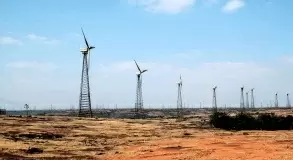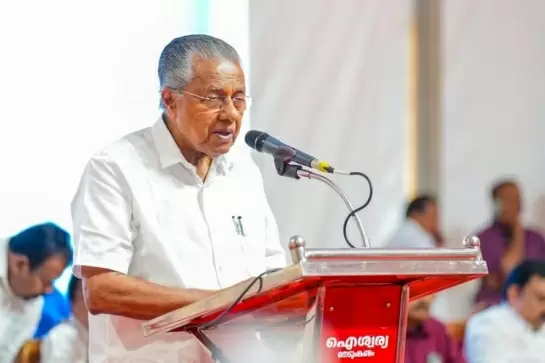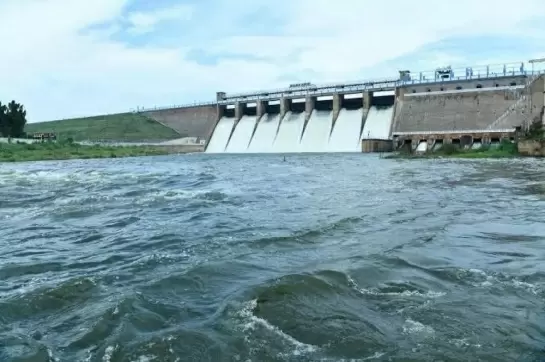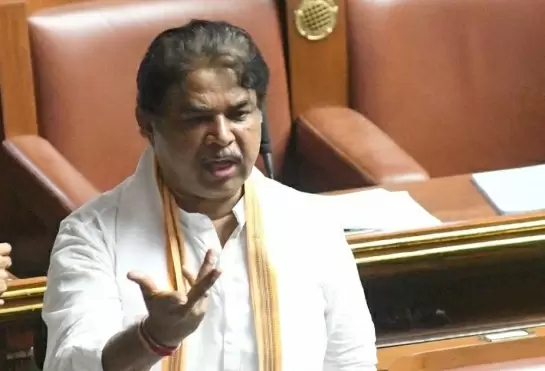All stories of companies earning carbon credits through CDM is just a myth
13-April-2012
Vol 3 | Issue 15
VILLAGERS IN Hirakud area of Odisha routinely face a peculiar problem. Their standing crops burn to cinders due to toxic fumes emanating from the aluminum smelter of the Hindalco Industries Ltd – a flagship company of the Aditya Birla Group.
The unaffected crop also carries a thick layer of dust and pollution. “Such damage has become routine here, and there is absolutely nowhere these villagers can go for justice. On top of that, the only water stream that the villagers depend on has also been polluted with effluents from the plant. The company does whatever it wishes and the administration is just a spectator,” says Nathu, a local activist.
 |
|
Wind mills at Satara plateau (Photo: GOI Monitor)
|
At Naradihi village near Hindalco plant of the Birla group, a middle-aged woman bursts into tears: “Tell us how we’ll survive? The ash and the effluents from the plant make our lives a living hell. The crops either are ruined or refuse to grow.”
Interestingly, the company is earning carbon credits for being “environment-friendly” by claiming to reduce the emissions of perfluorocarbon gases. This project is just one of the several industrial and development set ups which are milking the global business on climate change.
Under the clean development mechanism (CDM) adopted in 2001, private players and governments from developing countries can earn carbon credits by adopting better technologies, growing trees in degraded land or by adopting cleaner energy sources like hydroelectricity.
These carbon credits can then be sold to polluters in developed countries to help them meet their targets of emission cut. However, this has only proved to be an ‘environmental’ excuse for rich nations to keep polluting.
They discovered able allies/partners in the noveau rich of the developing countries, who sensed a windfall and jumped into the bandwagon. However, in stark contrast to what they promise, these projects invariably end up being big polluters showing complete disregard for the mandatory sustainability requirements supposed to be inherent in any CDM project.
A research report, ‘The Indian CDM: Subsidizing and Legitimizing Corporate Pollution’ by the National Forum of Forest People and Forest Workers (NFFPFW ) with NESPON and DISHA (Society for Direct Initiative for Social and Health Action) elaborates on how the supposedly clean businesses have dirty backyards.
The report analysed 34 such clean development mechanism (CDM) projects spread over the country and came up with startling findings. Some excerpts:
The CDM fraud
Fraud? Yes, one must clearly use the word, talking about carbon trading in general, and Indian CDM projects in particular. CDM has come as a boon for Indian companies, who are literally ‘making money from thin air’.
Among the countries in the Asia Pacific, China expects to earn the maximum number of carbon credits by the end of 2020 whereas India stands second with a total of 1,603 projects claiming to reduce 1516432 kCO2 by the end of 2020.
All the big names in the corporate kingdom have jumped into the fray — Reliance, Tatas, Birlas, Ambuja, ITC—disproving earlier apprehensions that market uncertainty and complex procedural nature of CDM would put off big companies.
More than 98 per cent of carbon credits issued so far went to the corporate sector and irrespective of sectors, all CDM projects studied so far display a surprising uniformity in community level impacts: they pollute (large and small industrial projects including the so-called ‘clean’ biomass power projects), displace (‘renewable’ and ‘green’ wind power and large and small hydro, large industrial projects) and destroy or enclose commons (forests, agricultural fields, pastures).
Not a single project was found to yield any discernible benefits for the local economy, society and environment. CDM projects generated no new jobs apart from a few temporary posts of security guards here and there, and all tall talks of corporate social responsibility etc disappeared once a project got going.
Some of the profit figures for companies engaged in the carbon trade are astounding. Till early 2008, the Jindal group made Rs 11 billion from selling supposedly ‘reduced emissions’ at their steel plant in Karnataka. The Tata Motors sold 163,784 carbon credits from clean wind projects at 15.7 Euros/CER in 2007.
The point is not why they are earning so much. The disturbing fact is that project design documents (PDDs) submitted by Indian CDM projects are full of half-truths and lies: claiming something, doing something else, and, in the end, showing yet another picture about what they have achieved.
Generating power from waste heat
A project run by Jindal Steel Works (JSW) Energy Ltd at Toranagallu in Bellary district of Karnataka was commissioned to generate electricity using imported coal and waste gas from JSW Steel.
The project is supposed to reduce emission of greenhouse gases (GHG) by increasing the proportion of waste gas in the fuel configuration for power generation.
A visit to the Toranagallu village and discussions with some Panchayat office bearers and villagers revealed that the plant is indiscriminately releasing toxic waste water into the canal that passes through the village, not only polluting the canal water but also the village pond (which is linked to the canal) and groundwater.
Even the water collected from tube wells is found to be toxic. This has also given rise to incidences of several water-borne diseases besides skin ailments and asthma due to unabated air pollution from the industry.
JSW has also illegally occupied the 600-acre village commons where there were plans of constructing schools, college, and an industrial training institute (ITI).
Though there were claims that the project will build a knowledge base about the operation of the waste-gas-based power generation, no such initiative to even make people aware about a waste-gas-based power system has been undertaken.
JSW got the land from the government at a throw-away price of Rs 10,000 to 15,000 per acre and promised all round development of the area but blatantly backed out on all their commitments about electricity supply, road construction, health facilities, employment benefits, and so on.
The JSW Energy has only constructed a few bus-stop sheds and two roads, which are mainly used by the company. Very few local people are engaged in the company as workers; most workers are from distant areas and even from other states.
Even coal is clean energy here
The irony of clean development mechanism (CDM) becomes starker when even coal-based plants manage to earn carbon credits claiming to be “environment-friendly”.
A power generation project by Adani Group at Tirora village in Gondia district of Maharashtra comes with a justification that adoption of a new technology (supercritical) in such projects will ensure less carbon dioxide emission in comparison with the existing subcritical technology scenario.
How can a thermal power project that will mine and burn millions of tonnes of coal for years to come even remotely be considered as a ‘clean’ project, let alone given the CDM status?
The Adani’s high-efficiency power-generation project claims to use less coal and hence improve the local environmental condition by reducing emissions of carbon dioxide and other air pollutants like sulphur dioxide and suspended particulate matter.
The project design document promises poverty alleviation through employment and improvement in quality of life through rural electrification initiatives in India.
However, field visits reveal that the 550 acre land on which the plant stands was originally acquired about 15 years ago by the state government for the Maharashtra Industrial Development Corporation (MIDC) from five villages.
The local people have been protesting to press for employment opportunities and compensations from the company for the land they have lost. Paying no heed to the protests, APML is going ahead with its work, without even procuring a no objection certificate from the panchayats.
The company also laid a big pipeline to lift water from Vainganga River destroying huge areas of fertile land in Thirekhani village. The project claims to achieve higher efficiency of power generation by reducing fossil fuel consumption but the company has not taken into account mining at Lohara and threat to rich forests and biodiversity, which people feel is a blow to the self-sustainability of the environment, local ecosystems, as well as people’s livelihoods.
The towering chimneys can be seen belching ‘clean, sustainable’ smoke while the plant management seems to have attained an absolute control over the village with help from police and private security guards who deter any outsider from talking to villagers.
Gone with the wind
The Satara valley in Maharashtra has around 1,000 wind mill plants as many companies got lured because of cheap infrastructure and bulk subsidies while the possibility of earning additional revenue through sales of carbon credits acted as another strong incentive.
It was found that private companies are selling electricity to the Maharashtra State Electricity Board (MSEB) at Rs 3.16 per unit but the same companies are consuming electricity provided by MSEB at the concessional rate of Rs 1.20 per unit.
Both the government of India and the Maharashtra government have been providing subsidies and cheap infrastructure to such ‘renewable’ and ‘green’ companies.
This happy combination of factors make a windmill project in Maharashtra an extremely attractive economic proposition, which does not require carbon credits to become viable, and would have come up even without the new subsidy in form of carbon revenue.
The wind power project of Bharat Forge Ltd at Kadve Khurd showcases other blatant violations by wind mill plants. There are seven power plants of 600-kW capacity each in its wind farm and the entire electricity generated is used in the BFL plant via MSEB grid network.
Kadve Khurd is located deep inside the forested hills of the Western Ghats. Today, 30 wind turbines stand in and around the village which had strongly resisted forcible acquisition of their lands.
Because the villagers only had old documents dating back to 19th century and earlier as proof of ownerships, the company did not bother to pay compensations.
Though a lower court had ordered stay on the plant's construction, it was vacated by the district collector’s court in Pune. The company also slapped several false cases of robbery and theft of equipment upon the agitating villagers. The wind turbines have brought neither electricity nor employment to the village but destroyed its only pasture.
The biomass excuse
Gayatri Agro-Industrial Power Ltd (GAIPL) envisaged a 6-MW biomass-based power generation plant at Kethepally village in Nalgonda district of Andhra Pradesh.
The project was to primarily utilise locally available biomass resources such as rice husk, paddy straw, castor stems, pulse stalks, and other renewable woody biomass (like juliflora) to generate electricity for a grid system of the state-owned power utility, Central Power Distribution Company Ltd.
It also promised to create employment for both skilled and unskilled rural youth by engaging them in collection and transportation of biomass resources to the plant site from the fields and rice mills besides direct work in the power plant.
However, reality is that the project is far from clean. Chikaligudem village, which comes under the jurisdiction of Kethepally village, sits next to the project area and is the worst affected.
Due to water and air pollution by the plant, residents are now forced to buy drinking water. The air pollution caused by the project activity has resulted in at least six cancer (in the nose) cases in the village. Respiratory and eye ailments are now commonplace.
The Vijaywada–Hyderabad National Highway has become a death trap, as frequent accidents due to the thick and blinding dust blowing even during the day. At night, villagers can no longer sleep in the open even in summers for fear of being engulfed by the dust. Thick layers of dust on the roofs of their houses bear testimony to their plight.
Initially, the company used to dump ash in the periphery of the village; but as the villagers protested, they now throw the ash straight into the Musi River, polluting the water used by tens of thousands of people downstream.
Dust has also destroyed agricultural land around the factory area. The plant has employed only 10 people of the area, that too, on a temporary arrangement in which they earn a paltry Rs 70 per day.
All the contracts for biomass procurement go to the rice-mill owners and big contractors. On top of that, all the waste biomass is procured from outside, in sharp contrast to the claim that biomass collection would provide additional livelihoods to the local people and also result in additional revenues for farmers for the biomass generated in their farms. Though the project is said to be biomass-based, coal is being used as a fuel abundantly.
Watery grave
Hydropower projects are prominent in India’s CDM kitty: 188 (as on June 29, 2011) dam projects in various parts of India have applied for CDM status. More than half of these are in the Himalayas, perhaps the biggest ones. The tiny state of Himachal Pradesh to the North of India alone hosts 57 projects.
Most of these projects have led to direct and indirect displacement of local people and triggered of disastrous environmental impacts: around the project areas, mudslides have become more frequent, water table is going down, and perennial springs are drying up.
The wholesale damming of important rivers and dam builders’ ownership control over river water inevitably mean less or no water for river valley agriculture. Besides, there are sociocultural impacts as large number of outsiders flock to the hitherto closeted mountain villages irreversibly disturbing the fabric of community life and their sustainable living.
It goes without saying that CDM projects in India are a far cry when it comes to clean development and community welfare. In fact, they are only destroying the concept of traditional lifestyles which were much less of a burden on the environment. (GOI Monitor)















